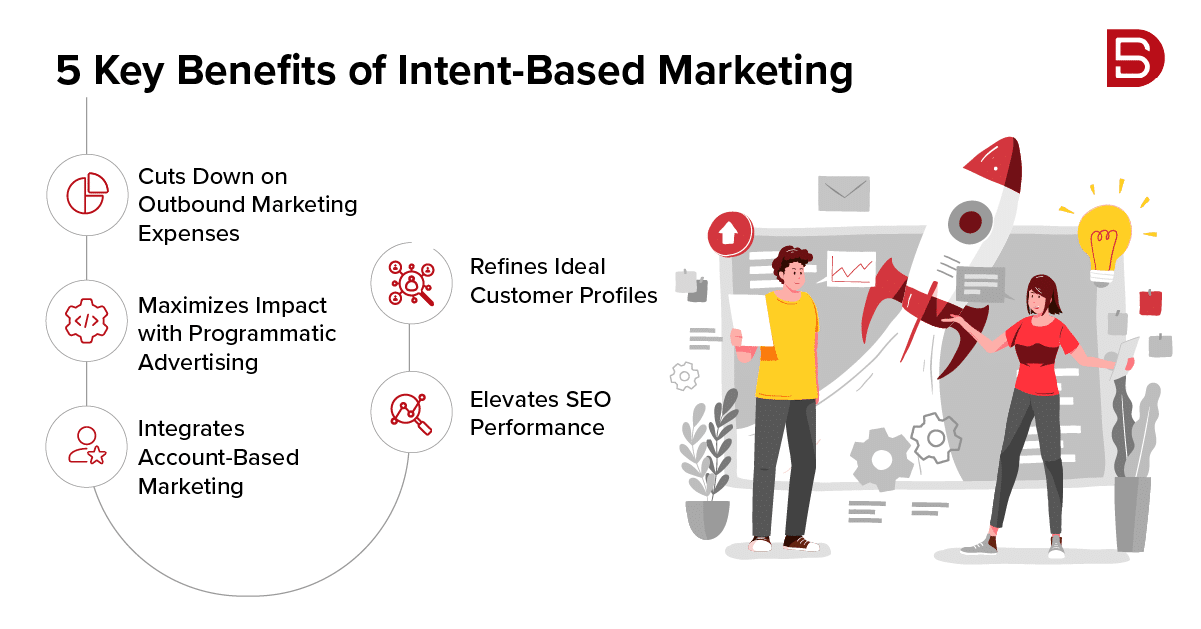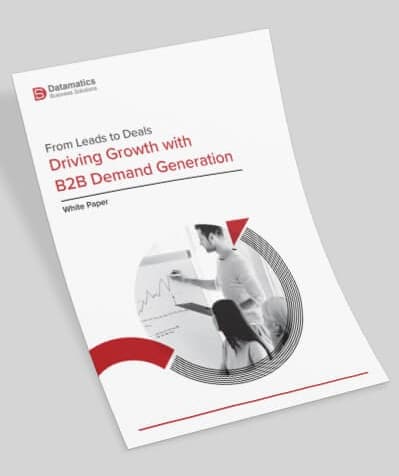“How can I tell when my B2B prospects are gearing up for a purchase?” This question has indeed been a long-standing challenge for B2B marketers. Thankfully, intent-based marketing comes to the rescue, offering a transparent and dependable solution. Intent data is a pool of behavioral insights extracted from users’ online content consumption.
Intent-based targeting empowers B2B marketers to align queries with remarketing ads, inbound content, and follow-up strategies, drawing insights from the underlying content. According to a Leadfeeder survey, over 76% of surveyed B2B leaders currently leverage buyer intent data to shape their sales and marketing strategy, with 65% planning to boost their investment in the coming year. This blog explores intent-based marketing, its concept, functionality, and the potential benefits it offers for your business.
What is Intent-Based Marketing?
Intent-based marketing is a focused strategy creating personalized experiences based on customers’ intent data signals. It employs sales and marketing intelligence technologies to identify and track potential consumers’ interests. B2B marketers evaluate a prospect’s urgency in finding a solution by analyzing online behavior, demands, and interests, categorizing intent into two clear categories.
- Active Intent: Or transactional intent, is when potential customers actively seek specific information about a product or service. It often signals a readiness to make a purchase, leading to a swift closing.
- Passive Intent: Or informational intent, is more about customers in the research stage without immediate pressure to decide.
Using intent-based marketing, B2B marketers strategically allocate spending to segmented audiences likely to hit that “buy” button. Common examples of passive intent include:
- Website visits
- Browsing tendencies
- Whitepapers/eBook downloads
- Product evaluations
- Page duration
- Content engagement
- Scrolling patterns
- Topic searches
However, handling vast amounts of raw data is a daunting task. Marketers, with limited time, can’t sift through millions of entries to identify behavioral patterns. Fortunately, some companies employ algorithms to do this work for us. They refine the data, making it valuable for marketers. Partnering with B2B data providers grants us access to this refined data, enabling better-performing marketing campaigns.
Unlocking 5 Key Benefits of Intent-Based Marketing
In a survey by Statista, a solid 90% of American consumers gave the nod to personalized marketing content, ranking it from “somewhat” to “very appealing.” This is where custom intent targeting comes into play, identifying the specific information potential clients are seeking and delivering messages, content, and touchpoints that address those needs.
The benefits of intent-based marketing are noteworthy, including richer consumer insights, elevated engagement and conversion rates, and an overall enhanced customer experience. Here are a few standout examples:
1. Cuts Down on Outbound Marketing Expenses
Marketers can direct campaigns to audiences showing a strong intent to purchase. This targeted approach ensures marketing funds are utilized more efficiently, as users are actively seeking similar products or services. By adopting this strategy, companies can reduce overall marketing costs and enhance their return on investment (ROI).
2. Maximizes Impact with Programmatic Advertising
Marketing teams tap into programmatic advertising platforms to roll out dynamic ads perfectly aligned with the content, topics, and websites that users frequent. Taking it a step further, users engaging with a set number of related articles receive personalized, targeted ads. This approach creates a more personalized and engaging experience, enhancing the overall effectiveness of marketing efforts.
3. Integrates Account-Based Marketing
Similar to intent marketing, account-based marketing hones in on high-value accounts. By leveraging data-processing tools, marketers can customize their follow-up messages to prospects, offering solutions to their ongoing research questions.
4. Refines Ideal Customer Profiles
Ideal Customer Profiles (ICPs) are detailed dossiers that paint a vivid picture of businesses ideally suited for your product. Intent data insights can then be harmonized with factors such as revenue, size, background, geography, industry, and technology usage, enriching the precision of these profiles.
5. Elevates SEO Performance
Engaging in search engine optimization (SEO) practices generates inbound traffic. By pinpointing the keywords, topics, and content types that resonate most with a target audience, it becomes possible to craft content that draws in more organic visitors.
Tips to Access Intent Data
The kickoff to intent marketing involves gathering consumer information. Yet, sorting out which data bits lead to the most significant topic searches is no easy feat. With every online user activity leaving a data trail, analytics channels get flooded with heaps of raw data, not all of which is immediately useful. To navigate this, it’s smart to organize client data into the following categories:
First-party intent data
Also called internal intent data, this encompasses all the data directly gathered from your own website. This includes information collected from submitted forms, IP addresses, gated content, and other shared resources, enabling the initiation of sales-oriented conversations with potential customers.
Utilizing website visitor tracking software capable of identifying even anonymous visitors facilitates the collection of internal intent data. These trackers employ demographic and behavioral filters to automatically evaluate leads based on their online activities.
Third-party intent data
This data refers to information collected from diverse online sources. This data opens up the opportunity to gather insights from other websites, including those of your competitors, allowing your business to deliver relevant content to prospects based on their online activity.
Intent data signals on the internet can be scrutinized using intent data tools. The most advanced tools can deduce the semantic meaning of the most popular web pages from ICPs.
The Art of Intent: A Close Look at How Intent-Based Marketing Works
The success of intent-based marketing strategies hinges on the integration of both inbound and outbound marketing initiatives. While the specific processes may vary depending on the industry and the size of your total addressable market, this serves as the standard framework for crafting a robust intent-targeting campaign.
1. Develop Your Target Account List
Your target account list (TAL) is the compilation of carefully selected ICPs by your sales and marketing teams from your entire addressable market. This comprehensive document should encompass all available information about your ideal client. It functions as a step-by-step guide for your team, outlining which organizations to contact first, when, and how.
2. Define Your Intent Topics
When it comes to establishing brand awareness, it’s crucial to pinpoint the keywords, subjects, and content strategies that align most closely with your business. This goes beyond mere visibility – it’s about understanding how potential customers are likely to encounter and engage with your brand online.
By delving into the content, they are already using during their research, marketing teams can craft strategies that resonate effectively with their audience, fostering a more meaningful connection. This approach ensures that efforts are not just about being present but are strategically aligned with the audience’s ongoing investigation.
3. Develop Intent-Based Content
Content creators can leverage intent signals as a roadmap. Intent targeting involves scrutinizing the top-performing blogs, social media accounts, and landing pages on the internet associated with the online searches conducted by your ICPs.
With data-driven insights, marketers can craft blog entries, whitepapers, product evaluations, and other content pieces, leveraging their understanding of what potential customers are actively seeking. This approach ensures that content creators produce highly engaging material tailored to the specific interests and needs of their audience.
4. Roll Out Intent-Based Ads
When users actively search for specific topics, phrases, and content sections on different landing pages, intent signals light up the radar, thanks to intent data. By leveraging intent-based targeting, you can attract consumers to explore your website and seamlessly navigate your sales funnels. You can achieve this by launching a mix of advertisements, including display, video, and audio formats tailored to resonate with their specific interests and inquiries.
Conclusion
To sum it up, mastering intent-based marketing requires a strategic blend of understanding your audience, creating compelling content, and leveraging intent signals. It empowers businesses to glean valuable insights into customer behavior, paving the way for crafting more impactful messages and, ultimately, driving increased conversions while minimizing customer churn. When done right, intent marketing becomes a powerful avenue for building loyalty and nurturing long-term relationships with customers.
If you’re ready to elevate your B2B data game, write to us at marketing@datamaticsbpm.com. We provide cutting-edge B2B data solutions to fuel your marketing strategies. Let’s embark on a journey to unlock the full potential of your B2B data.
 Select an element to maximize. Press ESC to cancel.
Select an element to maximize. Press ESC to cancel.
Paul van de Kamp




